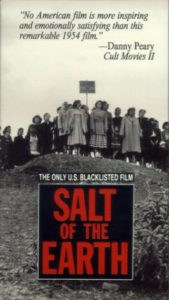 There are multiple methods of gaining insight and knowledge of one’s ethnic group. To obtain an accurate understanding of such, one can carefully examine another group’s cultural and ethnical demeanor/values for an extended period of study. As this may be efficient, the process is not easily obtainable where one is able to quickly put into practice. Televised media is another avenue for obtaining awareness of an ethnic group’s values and traditions, yet, it is not reliable as it may misinform its viewers and deliver a negative first impression. The film industry, specifically, portrays fictional and nonfictional accounts of history and historical figures. These displays may, however, may stigmatize a group or gender based on the actions performed in the storyline of a film. Furthermore, cinema creates a platform that addresses issues of gender-roles/inequality, conflict between the ethnic minority labor-class and their Anglo-superiors. The female characters of this film absorb the symptoms of inequality and yet transcend as they confront challenges when assuming multiple roles and responsibilities. Salt of the Earth is a film that presents these elements that exist among a mining community, substantially of Latina/o descent.
There are multiple methods of gaining insight and knowledge of one’s ethnic group. To obtain an accurate understanding of such, one can carefully examine another group’s cultural and ethnical demeanor/values for an extended period of study. As this may be efficient, the process is not easily obtainable where one is able to quickly put into practice. Televised media is another avenue for obtaining awareness of an ethnic group’s values and traditions, yet, it is not reliable as it may misinform its viewers and deliver a negative first impression. The film industry, specifically, portrays fictional and nonfictional accounts of history and historical figures. These displays may, however, may stigmatize a group or gender based on the actions performed in the storyline of a film. Furthermore, cinema creates a platform that addresses issues of gender-roles/inequality, conflict between the ethnic minority labor-class and their Anglo-superiors. The female characters of this film absorb the symptoms of inequality and yet transcend as they confront challenges when assuming multiple roles and responsibilities. Salt of the Earth is a film that presents these elements that exist among a mining community, substantially of Latina/o descent.
Salt of the Earth is a film about a mining community that issues a strike to address concerns of the occupational hazards that are accompanied with mining. However, conflict existed between other parties than that of the working members and company superiors/owners. The employees themselves were family men with wives that sought to be recognized as equals in the home just as the men towards their mining superiors. The women of the striking miners were not only in support of the strike, but also the backbone and bravado that the Latino men did not seem to possess enough of in order to achieve the goals of the labor-union. These examples are shown as the women react to the Taft-Hartley Act that prohibited men from continuing to protest against their employer malpractice, “…men are forced to end their picketing by a Taft-Hartley Act injunction the women take their place in the picket line…The women, indeed, come out looking stronger than the men, some marching with babes in their arms, resisting tear gas and making jail so unendurable for the sheriff that they are released” (Film.Society.Tripod). Additionally, women subdue and drive away authorities opposing the picket line. Alternately, the women’s involvement in the strike left the men to replace the household duties of the women. This left the men overwhelmed with the responsibilities that the women of the household seem to flawlessly and naturally perform. Character, Ramon Quintero, appears to be without a solution as his newborn baby is crying and daughter is asking to be fed. Moments later, his wife, Esperanza quickly resolves the infant’s crying with a bottle of milk. Another example of the incompetency of the Latino men in this film is observed when they lack the ability to come to a mutual agreement as well as one of the miners surrendering his loyalty to the company for his job security. Lastly, one can observe Esperanza’s broad awareness as she confronts Ramon about his employer’s disregard for employees and his lack of appreciation for his wife, “Why are you afraid to have me at your side? Do you still think you can have dignity only if I have none?…The Anglo bosses look down on you, and you hate them for it. ‘Stay in your place, you dirty Mexican’—that’s what they tell you. But why must you say to me, ‘Stay in your place.’ Do you feel better having someone lower than you?…Whose neck shall I stand on to make me feel superior? And what will I get out of it? I don’t want anything lower than I am. I’m low enough already. I want to rise. And push everything up with we as I go. …And if you can’t understand this you’re a fool—because you can’t win this strike without me: You can’t win anything without me!” (Ideology and Structure in Salt of the Earth).
The film, Salt of the Earth, depicts inequality between the working miners and the mine’s executive members. Specifically, the female figures of the film, were not only underappreciated, but were the solid foundation the men required to function about the work day and strike by up keeping the home, providing direction and feeding them while they marched in protest. The women of the film became the heroines, as the men were unable to go on about their labor force revolt. As for the lead protagonists, the character of Esperanza exhibited greater emotional intelligence, overall situational awareness, sensibility, resilience and capability than her male partner, Ramon. The Salt of the Earth significantly impacts the image of the Latino male as the women overtake and exceed the standards in both gender roles.
